Abstract
Several surveys demonstrated in the past a large heterogeneity of cardiology training and education in European countries. Taking into consideration the reality of the free movement of doctors and patients across borders, the cardiology community feels a strong need for the harmonisation of training and education of European health professionals. The ESC has already produced the standards, and recently developed the tool to deliver these standards: the ESCeL platform. This project is currently on the road to success. A challenge for the future is the possibility of massive participation of professionals, in thousands, not hundreds. Although this project raises a lot of questions and challenges it also opens a wealth of new possibilities for the future of our profession and particularly the delivery of a high standard of care to our cardiovascular patients.
ESCeL mission statement:
The highest European standard of training and education, to as many as possible, at the lowest cost possible.
Background
Because of the subsidiarity principle, the European Union is not directly involved in the healthcare policy of member states, but it is very interested in the free exchange of services, including medical services. In fact, health professionals (mainly doctors and nurses) are among the European professionals who travel the most across borders to work in other countries.
It is clear that the free exchange of professionals and services (goods and capital) within the European Union is guaranteed by the Treaty of Rome. Free exchange of professionals and services within medicine was established by the Commission of the European Community in 1975. The directives have been consolidated in the Directive 93/16/44C of 5 April 1993 []. A patient safety directive called the “Luxembourg Declaration on Patient Safety” was also published in 2005. In this declaration it was clearly recommended “to include patient safety in the standard training of health professionals combined with integrated methods and procedures that are embedded in a culture of continuous learning and improvement” [].
For these reasons, the European Union is paying a lot of attention to the harmonisation of medical education in Europe and to the safeguard professional standards in the field of medicine []. In order to achieve this goal, the delivery of harmonised high-standard training and education to healthcare professionals is essential. This harmonisation would facilitate the free movement of doctors across borders and would help patients have access to similar high standards of care across the different European countries. Scientific societies such as the European Society of Cardiology (ESC) are key players in the development of this harmonisation process.
However, this harmonisation of training and education is only the beginning of a long process. There will be a need in the future to reassure patients and regulatory authorities that qualified doctors keep themselves updated during their active professional life and are always able to provide their patients with a high standard of care. Therefore, it is reasonable to say that continuing medical education (CME) of doctors contributes to their continuous professional development (CPD) and that this is of utmost importance for patient safety reasons.
Continuing medical education based on electronic distance-learning educational tools may have a strong impact on “classic” interpersonal relationships and interactivity between members of professional scientific societies, and may change the medical learning process in the future. We are already living in a new era of e-learning and e-training.
This new world of electronic distance learning and electronic distance training is rapidly changing the strategies of many professional associations. In fact, in this new era information and communication technologies have created a new series of educational products and tools that have the potential to enhance network learning not only at national level, but also at an international global level. All these electronic tools, by increasing the effectiveness of CME for health professionals on a large scale, bring with them the possibility of reaching a massive number of physicians and other health professionals around the world, even in remote areas [,,,,]. Although these technologies present many questions and challenges they also open a wealth of new and exciting possibilities for the future.
Introduction
Cardiology is one of the most competitive specialties in medicine, and by its nature is leading many fields of medicine not only in Europe but also around the world. This leading role involves not only scientific research, but also organisational, training and educational aspects as well.
In terms of education and training the reality in Europe is largely heterogeneous. In fact, several surveys developed by the ESC over the years have clearly shown the existence of major discrepancies in terms of curriculum and duration of training between different European countries. In 2014, the European Association for Percutaneous Intervention (EAPCI) developed a survey with the goal of better understanding the current situation of the interventional cardiology training and education in Europe. The results of this survey were quite clear: there is a large heterogeneity in many parameters, including the duration of training needed to become a certified interventional cardiologist. The same is true for the number of procedures needed during the training. Data from another survey from the ESC showed that despite the fact that 66% of the countries reported having an educational platform, only 13% stated they had a training platform. This is probably the reason why 93% of these countries are willing to use ESCeL (ESC e-learning and training platform) at the national level.
The observed heterogeneity of education and training in Europe is possible because of the basic subsidiary principle of the EU member states and the lack of EU regulations that could force the standardisation and harmonisation of medical education and training in Europe. In order to help to change this heterogeneity in European education and training, the ESC took some strong steps forward.
The first step was taken together with the Union Européenne des Médecins Spécialistes Cardiology Section (UEMS-CS), which represents the profession at the EU level. These two organisations decided to create a specific body called the European Board for the Specialty of Cardiology (EBSC). In 1996, this organisation published a document of basic recommendations for the education and training of cardiology in Europe []. Taking into consideration the recognised urgent need for the harmonisation of training and education in Europe, some scientific societies, such as the ESC, decided to continue to move forward with the UEMS-CS collaboration, and developed a second step: the delivery, in 2006, of the “Core Curriculum for the General Cardiologist” []. This document was updated in 2008 [], and a new document was recently published in 2013 []. These documents were an attempt to provide a framework for the continuing medical education and training of European General Cardiologists by defining the teaching, learning and assessment methods. This ESC core curriculum for general cardiology should be considered the standard for the education and training of this specialty across Europe, and it is structured in three main areas: knowledge, skills and behaviours, and attitudes (professionalism). Beyond general cardiology, other subspecialties inside the ESC have developed their own core curricula [,]. ESC Nurses and Allied Professionals have recently published their own core curriculum [15].
Therefore, it is clear that at present we already have the standards, but the question still remains: how can we deliver these standards across Europe in a harmonised fashion? In order to answer this question the ESC then decided to start the third step: to develop an electronic tool that would be able to deliver these standards across Europe and, beyond Europe, around the world. This electronic tool is ESCeL (ESC e-Learning).
The ESCeL project structure
The ESCeL platform was developed with a modular structure (Figure 1) that would enable the platform to be flexible and be adapted easily to different needs, and thereby to promote harmonisation. Integrated in the three main assessment areas described in the ESC Core Curriculum (knowledge, practical skills and professionalism) there are within its structure 10 smaller basic modules.
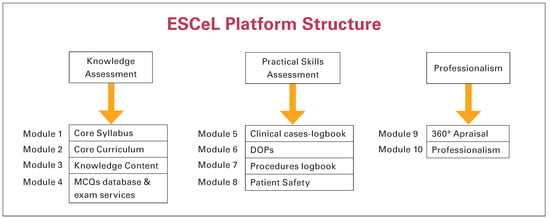
Figure 1.
The ESCeL platform modular structure. This structure was created in order to adapt easily to the different strategies and realities within countries and sub-specialties.
The knowledge area is based on the Core Syllabus and the Core Curricula, and follows their structure and hierarchy. Inside the different topics (chapters) there are courses dealing with one specific theme. Inside the course are a number of high-standard educational materials selected by a group of dedicated experts who are dealing with this specific theme. All these courses have in the introductory page a brief description of their content in order to give the user an overview of content before the decision is made to launch the course. Each one of these educational materials has a table of contents and the learning objectives. Inside the educational materials the user will find formative multiple choice questions (MCQs) intended, according to the learning objectives, to make sure the user is acquiring the most important pieces of information and not skipping any important point. As a formative MCQ an incorrect answer prompts the user to return to the related educational material, before attempting the question again. A progression bar shows where the trainee stands in terms of collecting the points needed to achieve the goals successfully. As a general rule, one point equals one hour of education.
The skills assessment area is formed by four components.
The first is the case logbook where the trainee is asked to upload a number of representative clinical cases from their clinical practice. In these clinical cases the trainee is asked to present a short history of the clinical condition, and upload the most relevant examinations the patient performed. Because of confidentiality issues and data protection all submitted data must be anonymised. Each case is reviewed together with the local trainer to trigger a discussion in such a way as to encourage constructive feedback from the trainer to the trainee.
The next module is Directly Observed Practical Skills (DOPs). While observing the trainee undertaking a procedure, the trainer completes a questionnaire comprising a standard set of evaluable steps. Typically these address how the trainee interacts with the patient, the patient’s family and other health professionals, and the trainee’s collaboration in the organisation and research within the department, among many other important aspects. DOP assessments are recommended at the beginning, in the middle and towards the end of the training period. If the local trainer detects areas where the trainee can improve their performance, then feedback is provided to the trainee and progress in these specific areas is evaluated when the next DOP assessment takes place.
In the procedure logbook the trainee logs all procedures undertaken during training. These numbers are signed off every month by the local trainer. After signoff, the trainee is not able to edit these numbers further. There are recommended indicative numbers of procedures that should be achieved during the training period, and the platform supports the trainee and the local trainer in this respect by automatically tracking the numbers.
The patient safety module is used by the trainee to log each month complications they have encountered.
These numbers are verified by the local trainer and after sign-off the trainee is not allowed to edit the content. This tool is helpful to support the trainees’ improvement of performance and involves the local trainer directly in this important part of the training process.
The professionalism area is formed by two components. One is a tool that supports the trainee in the systematic recording of their activities during the training period. At any time the trainee can generate a curriculum vitae in PDF or HTML format by simply pushing a button. A second discretionary component is a “360-degree” appraisal. If the trainee decides to use this tool, he/she invites a colleague, such as a nurse, a technician or a clerical secretary and a patient to evaluate the trainee at the beginning, in the middle and before the end of the training period. The evaluation is based on the personal perspectives of these people on the capacity of the trainee as a communicator, a collaborator, a manager, a health advocate, a scholar, and as a professional [16]. This anonymous feedback is sent to the trainee and to the local trainer. If there are areas where the trainee needs to improve, the local trainer can always support this improvement.
This modular structure is useful because it allows the platform to adapt to the different needs and strategies of the several groups that are going to use the platform. Moreover, it allows the platform to cope with the different realities within European countries. For example, while some groups of professionals, or countries, may want only to use the knowledge area or only use the skills area, other groups/countries may want to use the full capacity of the platform. Furthermore, if in the future the groups, or the countries, decide to change their strategy and add or remove other modules they can also do so easily.
The ESCeL platform was built in such a way that all institutions involved in the teaching and training (ESC, national societies, national accreditation authorities, training hospitals, training directors and local trainers) have specific roles and responsibilities. Without the active contribution of all these stakeholders the platform will simply not work at the national level. Therefore, the contribution of all these stakeholders is critical for the platform to work properly at the national level.
In terms of workflow (Figure 2), everything starts with the decision of the country (national society, national accreditation authority) to participate in the project. As soon as the national group informs the ESC that they want to participate, the ESC will ask the national group to provide a list of training hospitals, training directors and local trainers in this country. Once this information is registered, trainees from this country can start to enrol in the ESCeL platform where they will find this information. After trainee enrolment, the notice is sent automatically to the national society or national accreditation authority for verification. This is important to make sure that the person who has enrolled is legally entitled to undertake training, and to check if the training hospital, training director and local trainer are able to deliver training to the trainee. Only after sign-off of this national institution can the trainee start using ESCeL for training purposes. This is a critical contribution of the national group, and can only be performed at the national level.
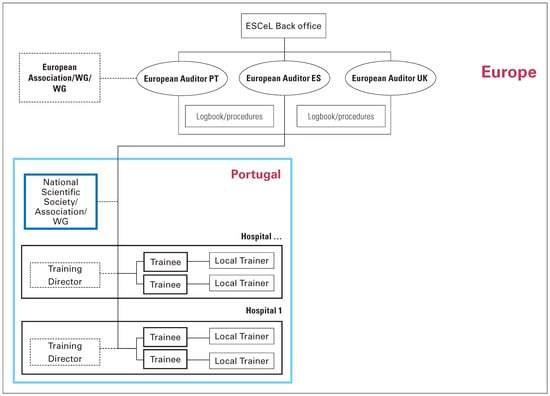
Figure 2.
ESCeL platform workflow. Interaction between the local trainers, trainees and training directors within the training hospital with the national society, at the national level. Interaction between the trainee, European auditor, and European scientific organisation.
The platform has two special features that are useful.
One is a set of tracking rules that ensure that all important steps in the training process are undertaken in the correct sequence. This tracking system is automated obviating the need for human intervention. For example, if a trainee uploads a clinical case in his/her logbook, or if the local trainer is due to sign off the last month’s number of procedures, the ESCeL platform detects that automatically and generates an e-mail requesting specific actions of the local trainer, training director and trainee. The ESCeL platform will only stop sending the e-mail when the requested action has been taken. This automaticity is required to deal with large numbers. It is an example of a strategy used by Massive Open Online Courses (MOOCs), whereby automated interactions lessen the requirement for human resources and the time needed to achieve goals [].
A second important feature available inside the ESCeL platform is the possibility for supervisors (local trainers and training directors) to view easily how their trainees are evolving, by accessing the trainees’ accounts at any time through the ESCeL platform. For the national societies it will also be easy to have a full perspective of the training process in their country and to see how the trainees inside the different training hospitals are performing. For the ESC it will be possible to have a view of all the countries, all the training hospitals and all the trainees. By using this approach it will be possible for the European auditors appointed by the ESC (experts in the field) to visit the trainees’ personal accounts through the ESCeL platform and give them constructive feedback on what they achieved and on how they can perform better in the future. This will be valuable for the trainee and will contribute to the progressive harmonisation of training across Europe and beyond Europe.
Finally, the platform is prepared to deal with interruptions of training due to sick leave, pregnancy or military service. It is also able to integrate training periods in different institutions, when trainees seek specific training in some highly specialised techniques.
ESCeL project, current situation
Since the official launch of the project in 2012, the ESCeL Project continues on its road of success. The platform was created to respond to the need of developing a harmonisation tool able to provide a high standard of training and education not only for Europe, but also beyond Europe, in the rest of the world.
The ESCeL platform is today the backbone of all the processes of education and training inside the ESC (Figure 3). In fact, ESCeL connects the work of several committees inside the ESC with the goal of providing education, training, certification and re-certification. Only the ESC can offer these different features all together. Needless to say all these ESC committees depend on the hard work of volunteers who spend thousands of hours to support their profession and their patients in Europe through their work in the ESC. The main goal of all this effort is to improve procedures, to deliver a high standard of training and education to our European cardiologists and, at the end of the day, to deliver a high standard of care to our European patients suffering from cardiovascular diseases.
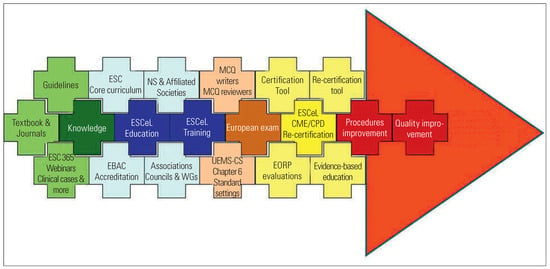
Figure 3.
The ESC “puzzle” of education, training, certification and re-certification. EBAC = European Board of Accreditation in Cardiology.
The news in 2015
The ESCeL platform project is an ongoing project that is continuously improving and adapting to changes and needs. Currently, it is bringing new features such as General Cardiology training (Figure 4), beyond the six subspecialties already available. The full delivery of the General Cardiology programme is expected to occur by the end of 2015.
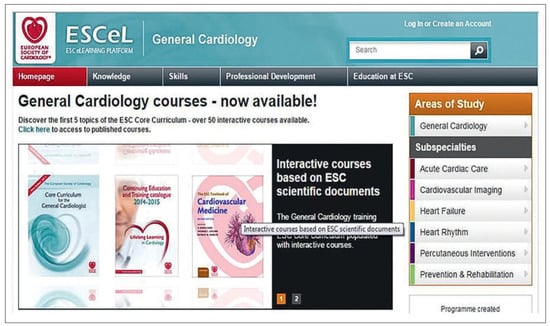
Figure 4.
The ESCeL General Cardiology Platform.
Another important new feature of the ESCeL platform is the possibility to allow continuous medical education (CME) and continuous professional development (CPD) not only for those who finish their training inside ESCeL, but also for those who are qualified doctors and want to be updated in their field of expertise.
Finally, the current version of ESCeL platform allows the provision of educational materials in local languages in parallel to the ESC educational materials in English. These educational materials in local languages can be the result of direct translation of ESC educational material (guidelines, consensus documents, textbook chapters, among many others) or can be produced originally at the national level and uploaded into the ESCeL platform after the approval of the ESC Educational Committee. The national societies that want to translate ESC educational materials into their national languages and upload them into ESCeL will be responsible for the scientific quality of the translation. Moreover, the costs associated with this translation process will also be supported by the national societies. This new feature is certainly important, not only for some European countries but also for other countries around the world as well. Several national societies have already showed the willingness to translate ESCeL contents into their national languages.
The ESCeL platform success can be demonstrated in several different ways. One is the high number of trainees/users, who already enrolled in ESCeL. They are coming from more than 20 different countries around the world. Another objective fact is the impressive number of courses produced in the last 4 years for ESCeL (Figure 5). The interest shown in this project by nurses and allied professionals and by our industry partners, is further testament to its success.
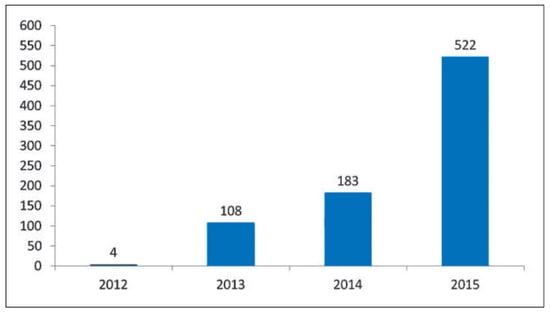
Figure 5.
Development of educational courses for ESCeL during the last 4 years.
The future: evidence-based education/ training and performance evaluation
With the support of educationalists it will be possible in the near future to include within the ESCeL project totally new concepts in the cardiology field, such as evidence-based education and training and objective clinical performance evaluation. With the continuous use of ESCeL we will be able to generate large amounts of valuable data (evidence). Moreover, randomised clinical trials on education and training will generate evidence as well. All this information will allow us to identify gaps (gaps assessment) and to design better education and training for the future.
Clinical performance evaluation has been based until now on the number of procedures the trainee needs to perform in a specific period of time together with a subjective evaluation of the trainee’s technical and cognitive skills. There are, however, better ways of evaluating clinical performance, by using innovative techniques within the ESCeL platform. One of these techniques is biomedical simulation. Biomedical simulation allows the objective evaluation of performance by measuring the number of errors, the quality of the decisions that are taken, the time needed to achieve the goal and whether the goal is achieved. However, simulation is not widely available and this lack of availability is expected to remain for the near future. One good alternative is the development of “micro clinical cases” that are created with the purpose of measuring the trainees’ performance in the presence of their mentor. By using these “micro clinical cases” mentors will be able to evaluate in an objective way several clinical performance parameters and to measure trainees’ progress.
These concepts are the new frontiers of medical education and training in cardiology and are expected to be available within the ESCeL project in the near future.
Conclusion
There is a large heterogeneity of cardiology training and education in European countries. Taking into consideration the reality of the free movement of doctors and patients across borders, the cardiology community feels a strong need for harmonisation of the training and education of European health professionals. The ESC has already produced the standards, and recently developed the tool to deliver these standards: the ESCeL platform. This project is currently on its road of success. A challenge for the future is the possibility of massive participation of professionals, in the number of thousands, not hundreds. Although this project raises a lot of questions and challenges it also opens a wealth of new possibilities for the future of our profession and particularly to the delivery of a high standard of care to our cardiovascular patients.
Disclosure statement
No financial support and no other potential conflict of interest relevant to this article was reported.
References
- The Executive Committee of the European Board for the Specialty Cardiology. Recommendations of the European Board for the Specialty Cardiology (EBSC) for education and training in basic cardiology in Europe. Eur. Heart J. 1996, 17, 996–1000. [Google Scholar] [CrossRef] [PubMed]
- The Luxembourg Declaration on Patient Safety. Available online: http://ec.europa.eu/health/ph_overview/Documents/ev_ 20050405_rd01_en.pdf.
- Cook, D.; et al. Internet-based learning in the health professions: A metaanalysis. JAMA 2008, 300, 1181–1196. [Google Scholar] [CrossRef] [PubMed]
- Lam-Antoniades, M.; Ratnapalan, S.; Tait, G. Electronic continuing education in the health professions: An update on evidence from RCTs. J. Contin. Educ. Health Prof. 2009, 29, 44–51. [Google Scholar] [CrossRef] [PubMed]
- Cook, D.A.; Levinson, A.J.; Garside, S.; Dupras, D.; Erwin, P.J.; Montori, V. Instructional design variations in internetbased learning for health professions education: A systematic review and meta-analysis. Acad. Med. 2010, 85, 909–922. [Google Scholar] [CrossRef] [PubMed]
- Harris, J.M.; Sklar, B.M.; Amend, R.W.; NovalisMarine, C. The growth, characteristics, and future of online CME. J. Contin. Educ. Health Prof. 2010, 30, 3–10. [Google Scholar] [CrossRef] [PubMed]
- Liyanagunawardena, T.R.; Williams, S.A. Massive Open Online Courses on Health and Medicine: Review. J. Med. Internet Res. 2014, 16, e191. [Google Scholar] [CrossRef] [PubMed]
- Core Curriculum for the General Cardiologist; The ESC Education Committee: Paris, France, 2006.
- Core Curriculum for the General Cardiologist; The ESC Education Committee: Paris, France, 2008.
- Gillebert, T.C.; Brooks, N.; Fontes-Carvalho, R.; Fras, Z.; Gueret, P.; Lopez-Sendon, J.; Salvador, M.J.; van den Brink, R.B.; Smiseth, O.A.; Griebenow, R. ESCcore curriculum for the general cardiologist (2013). Eur. Heart J. 2013, 34, 2381–2411. [Google Scholar] [PubMed]
- Curriculum and syllabus for interventional cardiology subspeciality training in Europe. Available online: http://www.escardio.org/static_file/Escardio/Subspecialty/EAPCI/about/Accredit_wg10_DiMario.pdf.
- Acute Cardiovascular Care Association Core Curriculum. Available online: http://www.escardio.org/static_file/Escardio/Subspecialty/ACCA/core-curriculum-ACCA-2014-FINAL.pdf.
- European Association of Cardiovascular Imaging Core Syllabus. Available online: http://www.escardio.org/The- ESC/Communities/European-Association-ofCardiovascular-Imaging-EACVI/Education/Core-Syllabus.
- Merino, J.L.; Arribas, F.; Botto, G.L.; Huikuri, H.; Kraemer, L.I.; Linde, C.; Morgan, J.M.; Schalij, M.; Simantirakis, E.; et al. Core curriculum for the heart rhythm specialist: Executive summary. Europace 2009, 11, 1381–1386. [Google Scholar] [CrossRef] [PubMed]
- Astin, F.; Carroll, D.L.; Ruppar, T.; Uchmanowicz, I.; Hinterbuchner, L.; Kletsiou, E.; Serafin, A.; Ketchell, A. Acore curriculum for the continuing professional development of nurses: Developed by the Education Committee on behalf of the Council on Cardiovascular Nursing Allied Professions of the ESC. Eur. J. Cardiovasc Nurs. 2015, 14, S1–S17. [Google Scholar] [CrossRef] [PubMed]
- rank, J.R. (Ed.) The CanMEDS 2005 Physician Competency Framework. Better Standards. Better Physicians. Better Care; The Royal College of Physicians and Surgeons of Canada: Ottawa, ON, USA, 2005. [Google Scholar]
© 2016 by the author. Attribution - Non-Commercial - NoDerivatives 4.0.